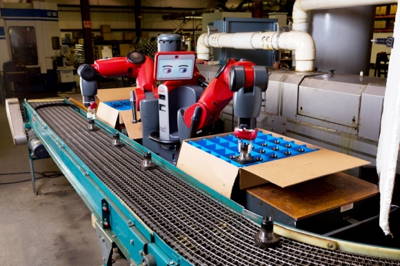$22,000 robot for SMEs is `the first to apply common sense`
A US company has unveiled a two-armed humanoid robot that, it says, is the first one capable of applying common-sense behaviour to manufacturing environments. Rethink Robotics predicts that its “affordably priced” Baxter robot, which is safe enough to work alongside people, will redefine how manufacturers use robots.

Based on the vision of Rodney Brooks, a former director of the MIT Computer Science and Artificial Intelligence Lab, Baxter is said to break down the cost and safety barriers that have limited the use of robots until now.
“Roboticists have been successful in designing robots capable of super-human speed and precision,” says Brooks, who is Rethink’s founder and chief technology officer. “What’s proven more difficult is inventing robots that can act as we do – in other words, that are able to inherently understand and adapt to their environments.
“We believed that if we could cross that chasm with the manufacturing environment specifically in mind, we could offer new hope to millions of American manufacturers who are looking for innovative ways to compete.”
Brooks suggests that his robots are groundbreaking in six different ways, because no other product on the market can:
• Apply common sense to its environment Baxter understands and can adapt to the way the world works. For example, if it drops an object, the robot knows to get another one before trying to finish the task.
• Work safely alongside humans Baxter comes with sensors and software to help it see and understand its environment. These allow it to work next to people without needing protective cages or light curtains.
• Be trained with no expertise Unlike traditional robots that need sophisticated software programming, Baxter can be trained as you would teach a person. Factory workers can interact with the robot directly to train it to do a task in less than 30 minutes.
• Offer broad task flexibility Because of its versatility and the short amount of time it takes to retrain, Baxter can take on different tasks over timescales as short as a day. This flexibility could appeal to contract manufacturers who need to make quick adjustments to meet demand.
• Bring automation to manufacturers of all sizes Baxter was designed to appeal to small and mid-size manufacturers who have not been able to afford robots before. The US list price is $22,000 and there are no integration costs. If it operates eight-hour shifts for three years, Baxter’s hourly running cost will be about $4.
• Go from delivery to the factory floor in an hour Baxter is a self-contained system and does not need extra capital investment or custom software.
Instead of driving the arm joints directly, Baxter’s motors drive springs that move the joints, providing elasticity which, coupled with force sensors, provides feedback. If one of its arms hits an object, the robot senses this and slows down. Each arm has seven degrees of freedom and can move 2.3kg loads at 1m/s. Together, the arms can achieve up to 12 pick-and-place operations per minute.
There are five cameras and a sonar sensor that scans around the robot to sense the presence of nearby people or obstacles. Baxter’s “head” incorporates a screen showing a “face” with eyes that animate to inform workers of where the arms are headed next, or to look surprised if something unexpected happens.
“Our guiding vision was to create a robot that would break the mould in two distinct ways,” says Rethink CEO, Scott Eckert. “First, the robot had to inherently function in a totally new way. We also set out to create a hardware and software platform that could be extended in limitless directions through new software applications.
“As we release new software that expands Baxter’s abilities,” he adds, “our customers can take advantage by simply updating the software on their robot. And with the SDK (software development kit), the opportunity to think of novel ways to use Baxter is open to the world at large.”
The first shipments of Baxter started in October





